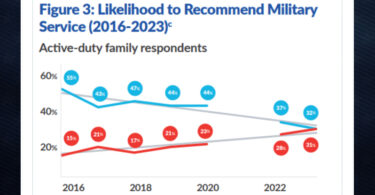By Scott McQuarrie, USMA 1972
I have confirmed that USMA, USNA and USAFA are studying how to revise their admissions requirements to eliminate (or make optional) the current requirement to submit a standardized test score (SAT or ACT), or possibly to reduce their weighting in the academic composite of the Whole Candidate Score (WCS). WCS is used to rank all applicants. No decisions have been made (they may do nothing).
Schools across the country are doing this (some have already done it) in anticipation of an “adverse” decision in the Harvard/UNC case, where most expect SCOTUS will ban the use of race in college admissions.
SAT scores (together with the race of applicants who are accepted or are rejected) are a principal means of demonstrating that race was a component of the school’s decision-making process, and eliminating SAT scores is a way of making the schools’ use of racial preferences more difficult to prove.
(This response – eliminating SAT scores – was predicted, since the Equal Protection Clause clearly prohibits use of race; thus most expect SCOTUS will rule that enforcement of the Equal Protection Clause must resume and therefore colleges must discontinue considering race.)
Some advocates of eliminating SAT/ACT scores claim that they disadvantage minorities.
Now, DoD is contemplating joining the herd. What their stated justification will be, if they do so, is unclear.
For those of you not aware, DoD twice admitted in their 2022 amicus brief at SCOTUS that the service academies have been considering race in their admissions decisions (and claiming that there is a “national security imperative” that they be allowed to continue doing so).
That acknowledgement unfortunately misled the court by stating, erroneously, that race is only one of many factors, when the truth is that race sometimes is the deciding factor.
An internal USMA document expressly authorizes selecting a candidate for diversity purposes, even to the point of leaving other applicants with higher whole candidate scores unadmitted.
Former admissions officers at USNA and USAFA have confirmed (in writing) it was their practice.
Data from USMA prove the significantly deleterious consequences (higher attrition, lower CQPA scores at graduation) for the “favored” categories.
Use of race to make admissions decisions occurs mostly in the “Additional Appointee” category of appointments to fulfill what USMA calls “Class Composition Goals.”
DoD’s brief also failed to tell the court that the expressly stated purpose (at USMA) of considering race in admissions is to “balance” diversity in the Corps of Cadets, a practice (racial balancing) SCOTUS has in the past ruled “patently unconstitutional” and incurable by use of the label “diversity.”
In an unguarded moment, an admissions data analyst who is involved in studying possible changes said that SAT/ACT scores are the only reliable way to compare one candidate to another in the area of academic preparedness to succeed as a cadet. Grading standards vary too much even within the same school district so that GPA and class rank are often not a reliable comparator, he said.
RAND Corp. studies done at USAFA (2016) and USMA (2015) (USNA declined to be studied) showed that SAT/ACT was a statistically significant predictor of academic success as a cadet, graduation, and success as an officer. RAND’s recommendations even included increasing SAT’s weighting in the USAFA report.
REPORTS
United States Service Academy Admissions: Selecting for Success at the Air Force Academy and as an Officer (RAND, 2016)
United States Service Academy Admissions: Selecting for Success at the Military Academy/West Point and as an Officer (RAND, 2015)
How Effective Are Military Academy Admission Standards? (RAND, 2016)
An Analysis of the Effect of Quantitative and Qualitative Admissions Factors in Determining Student Performance at the U.S. Naval Academy (Naval Postgraduate School Thesis by Barton L. Phillips, 2004)
This subject is of considerable importance. If the academies eliminate standardized testing as an admissions requirement, or even if they just reduce the weight given to standardized test scores, such would likely adversely affect quality of the incoming classes (for reasons that will be evident below).
My hope is that Congress will be alerted to this by concerned academy graduates (and others) and will communicate to DoD that any consideration along these lines should stop and that changes whereby standardized test scores would not be required, or their weight in scoring applications reduced, would not be well-received on Capitol Hill.
The following background might be helpful in understanding the subject for those unfamiliar with USNA’s recent practices and what data analyses have shown.
The term “Whole Candidate Score” mentioned in the first paragraph of the above first paragraph refers to the objective score the USNA Admissions Office assigns to each application to facilitate rank ordering applicants used for some appointment categories.
USNA Admissions Practices
USNA is also required to rank order applicants, but it uses different terms. As of 2004, USNA’s term was “Whole Person Multiple.” I don’t know whether it has since changed, and if so how.
Since USNA was not studied recently in the same manner as were USMA and USAFA (explained below), I digress here to explain briefly what little information is available to me re USNA admissions selection practices and in particular, its use of standardized test scores and what some data showed regarding their relation to likelihood of graduation and order of merit at USNA.
The attached Naval Postgraduate School thesis (2004) studied one aspect of the USNA admissions process, the effect of so-called “qualitative” measures of applicants’ qualifications on their success at USNA and interaction between that qualitative measure and quantitative measure of qualifications as predictors of success.
It begins by explaining that the Whole Person Multiple consisted of a composite of a quantitative measure called “Candidate Multiple” (“CM” consisting of such things as SAT/ACT scores and GPA) to which was added a “qualitative” measure of “unobservable traits” called the “Recommendation of the Academic Board” (“RAB”). So, CM plus RAB equalled Whole Person Multiple, at least in 2004.
Figure 9 (p. 29), the author says, shows “that African American candidates have a considerably lower mean candidate multiple as compared to other candidates…. The difference in mean candidate multiple scores clearly indicate a gap in initial qualifications and observed performance coming out of high school for African American ethnic group. This gap … lead us to believe that on average an African American candidate may be treated differently by the Admission Board if they are to overcome the candidate multiple gap.”
Figure 9 and the above language thus indicate that some candidates’ lower mean CM indicated lower mean quantitative scores such as SAT/ACT and GPA as compared to those of other applicant demographic categories.
Page 47’s discussion of “step two” indicates a positive correlation between CM and graduation rate was found. Similarly, the discussion on pages 52-53 regarding order of merit says the data “translates into minorities being ranked from 70-160 places lower than whites even after one accounts for their Candidate Multiple and RAB scores” and “project a continued challenge to the Admissions Office when they award nominations to ethnic minorities who are less likely to graduate and to perform below that of the majority white midshipmen.”
The discussion (page 53) of Table 12 includes, “higher Candidate Multiple scores are expected to improve a graduate’s overall relative class standing by approximately 1.8 to 3.0 percentage points or by 18 to 30 positions for each 1,000 point higher CM score.”
The Summary (p. 71) says “The performance models reveal minorities, on average, are less likely to graduate, more likely to be lower in Order of Merit, and more likely to have a lower academic and military grade point average.”
The above would seem to confirm that (as of 2004 at least) USNA Admissions used standardized test scores (in addition to GPA) and that they have contributed meaningfully to useful prediction of success as measured by graduation rates, OOM and GPA.
This background, along with results of studies conducted at USMA and USAFA, may be relevant when understanding the utility of USNA’s current consideration of eliminating or reducing the use of standardized test scores.
My source
My confirmation re USNA’s considering changes in this regard was a recent telephone conversation with an officer working in USNA Admissions. The fact that the USNA Dean’s Office is studying whether, and if so how, to change the requirement to submit standardized test scores with admissions applications was directly stated.
Legal/political background
In 2013, SCOTUS issued its opinion in Fisher I, reversing lower court rulings in an affirmative action case against the Univ. of Texas. The majority opinion (7-1, authored by Justice Kennedy) was strong in limiting the acceptability of the use of racial preferences in college admissions and announcing a strict standard of review.
But instead of reversing and rendering judgment for the plaintiff (Abigail Fisher, who had alleged racial discrimination in admissions practices), SCOTUS instead returned the case to the 5th Circuit instructing them to review the record again, this time applying the correct (more strict) standard of judicial review.
The 5th Circuit did so, again ruling in favor of the University of Texas. That decision was appealed to SCOTUS, which in 2016 issued its Fisher II ruling (again authored by Justice Kennedy). This second time, however, Justice Kennedy saw things somewhat differently, and the decision was 4-3 in favor of UT (only 7 justices participating) in a sharply divided court.
It’s conceivable (just my speculation) that during that period (especially after the 2013 opinion in Fisher I), DoD began realizing that the days of affirmative action in college admissions might be numbered, and that Grutter’s 2003 (5-4) precedent was unlikely to last for very long.
As a result, some Pentagon leaders (if irrevocably committed to diversity at any cost) might have begun to explore how they could make racial preferences in service academy admissions more difficult to prove (as some in academia were doing). The obvious answer would be to eliminate SAT/ACT scores of admitted and rejected applicants, which along with those applicants’ races had been the principal evidence used in racial preferences lawsuits.
It’s also possible that advocates of eliminating standardized test scores within DoD believed that SAT scores could not be proved to correlate with success at the academies, or to success as officers after graduation.
Alternatively, those who resisted eliminating standardized testing (there was, as of then, abundant evidence suggesting that standardized test scores were valid predictors of success at USMA), might have pushed back against the idea and argued that the issue should be studied for evidence of statistically significant correlation.
The RAND studies
Whatever the landscape within DoD at the time, around 2014/2015 DoD asked RAND Corp. to study the validity of the admissions processes at USMA, USNA and USAFA as a way of predicting success there and in the service later.
If RAND found no statistically significant predictive relationship between standardized test scores and success at the academies or as an officer, DoD would then have a basis for directing their elimination.
The results, however, generally confirmed the results of earlier studies. Statistically significant, positive correlations were found at USMA and USAFA, the only two institutions RAND was able to study.
From the Preface (p. iii) of the RAND report (2016) on USAFA Admissions (attached):
“RAND was asked by the Office of the Under Secretary of Defense (Personnel and Readiness) to examine admission standards at the military academies to see whether the academies were enrolling not only individuals who would be successful in graduating from the academies, but also those who would be successful officers in their respective service. This report focuses on admissions to the United States Air Force Academy. A companion report (Hanser and Oguz, 2015) focuses on admissions to the U.S. Military Academy at West Point. The U.S. Naval Academy declined to participate.”
Why USNA did not want its admissions practices studied by RAND is unclear.
Comment from LTG Rod Bishop, USAFA ’74, USAF ret:
Yet another manifestation of the DEI culture invading the military, Scott. Besides the Rand studies of the last decade, we contracted on another one at USAFA in the early 1980s when I worked in USAFA admissions–with attrition rates in the 40% of each class, the Superintendent pressured USAFA Admissions to find out which of the selection criteria we were using was the best predictor of “success”–i.e., graduation and serving a 20 year career.
By far the best correlation was the “Academic Composite”–a weighting derived from a combination of the SAT/ACTs and the HS rank in class. Standardized test scores were always the first thing we looked at.
Yesterday, I met a woman at a Congressional District who runs the Academy selection process for the Congressman. I asked her if she had heard about the discussion about eliminating standardized test scores–her response–“no, that would be insane.”
Additional information from Col John Brockman, USAFA ’74, USAF ret
It is fortuitous that Heather MacDonald, author and researcher at The Manhattan Institute, recently released her newest book “When Race Trumps Merit: How the Pursuit of Equity Sacrifices Excellence, Destroys Beauty, and Threatens Lives“. Her writings are heavily footnoted and this one is no exception.
Below are just a few highlights I excerpted regarding standardized testing, specifically the SAT and ACT which is in the section on “The Bias Fallacy”. I included her referenced notes below each selection.
The American College Testing organization, which administers the ACT, rated 10 percent of black high school seniors college-ready in math in 2021, compared to 44 percent of whites. Six percent of black twelfth graders were fully college-ready when ACT scores in English, science, and reading were taken into account along with math. Whites were five times as likely to be ready for college-level work in all four ACT subject areas.
39 “Black Students’ Scores on the ACT Test Continue to Fall and the Racial Gap Widens,” The Journal of Blacks in Higher Education, filed in Research & Studies on October 18, 2021, https://link.edgepilot.com/s/cac9f5e6/iL_33mwo30iytS8-hs7UdA?u=https://www.jbhe.com/2021/10/black-students-scores-on-the-act-test-continue-to-fall-and-the-racial-gap-widens/.
The College Board, which administers the SAT, used to report SAT scores in fifty-point increments (on an 800-point scale). Such information shows how racial groups cluster at the highest and lowest tails of the SAT curve, a distribution that predicts eligibility for the most cognitively demanding professions. (In the late 2010s, the College Board stopped reporting SAT scores in fifty-point increments, presumably on the usual equity grounds.) In 2015, only 2 percent of all test takers with a math SAT between 750 and 800 were black, according to the Brookings Institution. Sixty percent of math scorers in the 750 to 800 tranche were Asian, and 33 percent were white. By contrast, blacks made up 35 percent of all test takers with rock-bottom scores between 300 and 350. Whites made up 21 percent of such low scorers, and Asians made up 6 percent.
40 Richard Reeves and Dimitrios Halikias, “Race Gaps in SAT Scores Highlight Inequality and Hinder Upward Mobility,” The Brookings Institution, February 1, 2017, https://www.brookings.edu/research/race-gaps-in-sat-scores-highlight-inequality-and-hinder-upward-mobility/.
Physicists, mathematicians, and the most cutting-edge medical researchers and engineers are ordinarily drawn from an applicant pool that received the uppermost range of math scores. In a meritocratic hiring system, the most challenging jobs in law and finance will also be filled from that upper range. As for average SAT scores, the average total SAT score in 2021 (on a 1600-point scale) was 934 for blacks. For whites, the average score was 1112, and for Asians, it was 1239.
41 “Fast Facts: SAT Scores,” National Center for Education Statistics, accessed October 15, 2022, https://nces.ed.gov/fastfacts/display.asp?id=171.
Most white and Asian students who presented a combined SAT score of 934 would have little chance of admission to a selective college. The SAT gap is replicated in graduate-level standardized tests. Between July 2020 and June 2021, the average score on the quantitative section of the Graduate Record Exams (GRE) for US citizens was 150.7 out of 170. The Asian average was 154.9; the white average, 151.1; and the black average, 144.6.
42“A Snapshot of the Individuals Who Took the GRE General Test,” ETS, accessed November 18, 2022, https://www.ets.org/pdfs/gre/snapshot.pdf, 6-7.
As long as data on the skills and behavior gaps remain available, it is possible to challenge the myth of bias, at least in theory. So those facts must themselves be canceled, as well as anyone who publicizes them. That is the ultimate motivation for the movement to end the use of standardized tests in admissions. All minimally selective institutions of higher education practice race-norming in the evaluation of test results already, meaning that they judge the scores of blacks and Hispanics on a different scale than those of whites and Asians. The cutoff score, below which the school will not consider an applicant, is much higher for whites and Asians than for blacks and Hispanics.
Standardized tests do not impede racial preferences; colleges simply ignore the results for the sake of diversity. The reason to eliminate standardized assessments is rather to put the College Board and the Educational Testing Service out of business entirely—and with them, any possibility of an objective measure of intellectual skills. The College Board was dealt a body blow in May 2021 when the University of California barred the consideration of the SAT and the ACT in admissions. The SAT and ACT are “racist metrics,” according to a lawyer who challenged the University of California’s use of objective admissions tests.
63 Giulia McDonnell Nieto del Rio, “University of California Will No Longer Consider SAT and ACT Scores,” New York Times, May 15, 2021, https://www.nytimes.com/2021/05/15/us/SAT-scores-uc-university-of-california.html.
Nearly 2,000 colleges have banned the submission of college entrance test scores or made submission optional, but none have the financial clout of the University of California, the largest consumer of College Board products. Graduate programs have been dropping the GREs because of their disparate impact. In a sample of eight STEM disciplines at 50 top-ranked universities, the percentage of programs requiring the GRE General Test dropped from 84 percent in 2018 to 3 percent in 2022. Thirty-six percent of the programs surveyed by Science magazine banned GRE submission entirely in 2022. The GRE “unfairly privileges” white men, a Boston University professor told Science.
64 Katie Langin, “‘GRExit’ Gains Momentum as Ph.D. Programs Drop Exam Requirement,” Science, (2022), https://www.science.org/doi/epdf/10.1126/science.adg0520.
The rejection of objective standards of accomplishment is nihilistic. One could argue that the academic skills gap itself reflects structural racism in the distribution of school funding and private capital. (Such a claim ignores the billions of public and private dollars that the US, with the best of intentions, has allocated to close the gap.)
But to maintain that color-blind tests are meaningless in demonstrating cognitive mastery is to deny the very possibility of assessing accomplishment. Knowledge and skill exist, and they are measurable—if not always perfectly.
Standardized tests are under attack only because blacks and Hispanics, on average, score poorly on them.
The SAT was developed in the mid-twentieth century to overcome college admissions biases that favored traditional White Anglo-Saxon Protestant (WASP) elites. It allowed students from non-elite backgrounds and social classes to demonstrate superior academic capacity.
Now, because of disparate impact, the diversity movement deems color-blind measures of competence to be unjust instruments of racial exclusion. If there were no group differences in outcome, however, no one would think about eliminating the very measures that were introduced to overcome group favoritism.
America’s elites have apparently decided that if, after five decades of massive financial outlays on inner-city education, income transfers, and social services, the academic skills gap has still not closed, it is time to break up the objective yardsticks that measure it.
Thousands of blacks outperform whites and Asians thanks to study and self-discipline.
But the ubiquity of racial preferences casts doubt on their achievements and leaves them open to the suspicion that they advanced because of the color of their skin.
The question, ‘Do you owe your college seat or your job to affirmative affirmative action?’ is not racist. The question is almost unavoidable under the current regime.
One matter is clear: IQ is the strongest predictor of success with conscientiousness second. Standardized test scores are correlated with IQ.
The argument that IQ and standardized tests are constructed to lend advantage to white or Asian intellectual processes is fallacious.
As long as the tests require abstraction, logic, and deductive reasoning, those who score highest in the SAT and ACT will score highest in any similarly constructed test that attempts to cater to racial, cultural, and ethnic parameters.









Leave a Comment